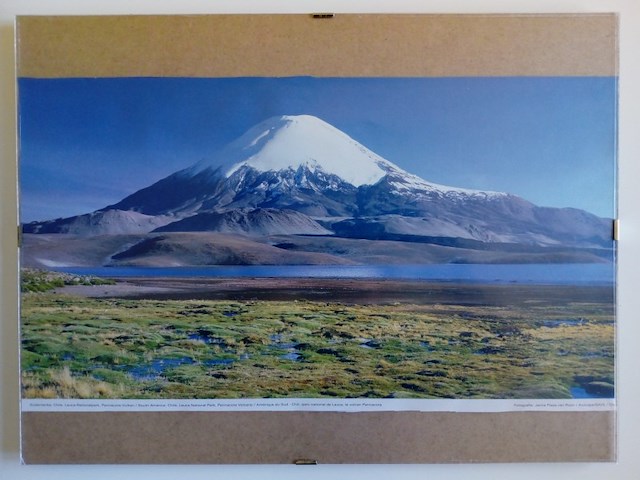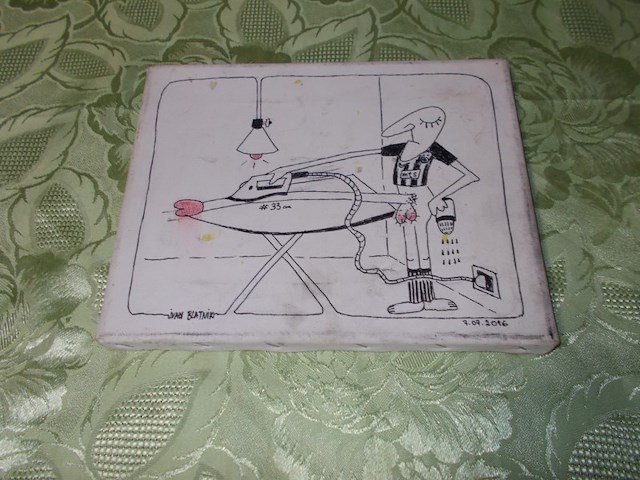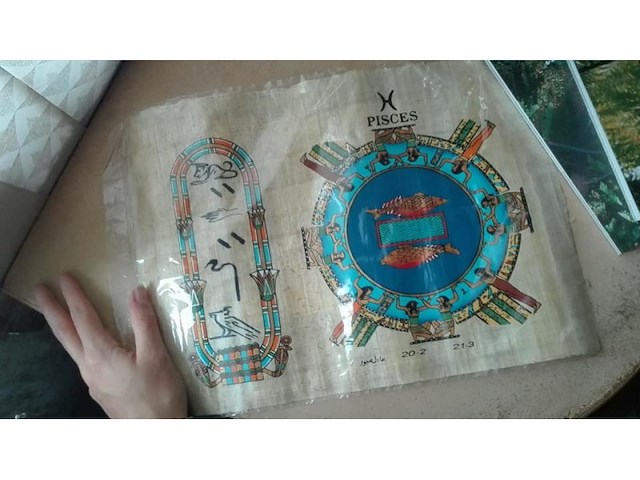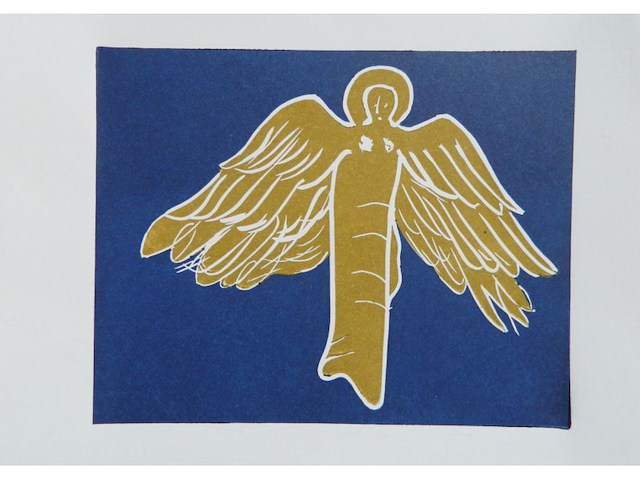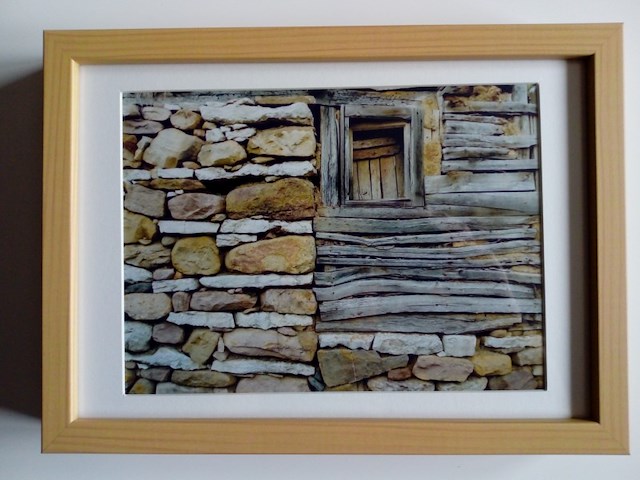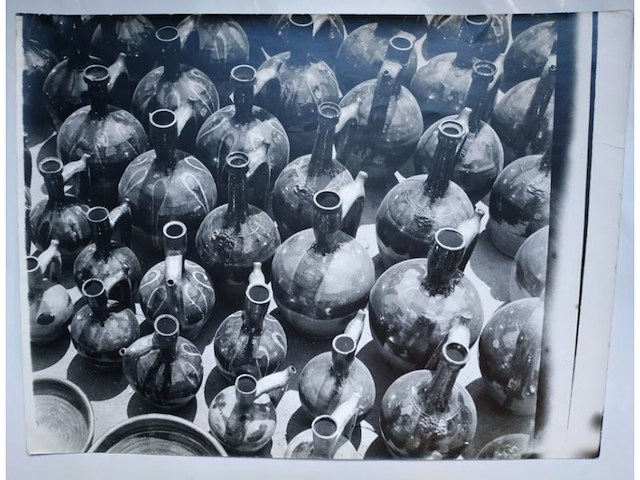Pratite promene cene putem maila
- Da bi dobijali obaveštenja o promeni cene potrebno je da kliknete Prati oglas dugme koje se nalazi na dnu svakog oglasa i unesete Vašu mail adresu.
26-50 od 1644 rezultata
Režim promene aktivan!
Upravo ste u režimu promene sačuvane pretrage za frazu .
Možete da promenite frazu ili filtere i sačuvate trenutno stanje
predratna ORIGINALNA fotografija GLADYS SWARTHOUT iz 1937. glamur glamour film movie veliki format dim. 26 x 20 cm Gladys Swarthout (b. December 25, 1900, Deepwater, Missouri – d. July 7, 1969, Florence, Italy) was an American mezzo-soprano opera singer and entertainer. While studying at the Bush Conservatory of Music in Chicago, a group of friends arranged an audition for her with the Chicago Civic Opera Company. Much to her surprise, she ended up with a contract, though at the time she didn`t know a single operatic role. By her debut a few months later, she had memorized 23 parts and participated in over half of the season`s operas. She sang for the Ravinia Opera Company of Chicago for three seasons. In 1929, she made her debut with the New York Metropolitan Opera Company, where she was a participant for several decades. Swarthout`s role as Carmen was well respected. She regularly worked eight hours a day with vocal coaches, and would spend an hour or more singing duets with her husband, Frank Chapman, also an opera singer. She also advocated inflating balloons and blowing bubbles to strengthen the chest. She also wrote a semi-autobiographical novel entitled Come Soon, Tomorrow: The Story of a Young Singer first published in 1943 that went through at least seven printings. She starred in five films for Paramount Pictures, including Rose of the Rancho, Romance in the Dark, Give Us This Night and Ambush. For the movie Champagne Waltz with Fred MacMurray, she sang her songs in five languages, including French, German, Italian, and Spanish for the foreign versions of the films. Swarthout also performed on a number of opera shows on television. In one of her final public singing performances, she did a concert in January 1951 at the Met. She continued to make public appearances, including an appearance on What`s My Line? in 1951. The Railroad Hour presented Martha on February 22, 1954. She was often heard on radio programs, including those of General Motors, RCA-Magic Key, Camel Caravan, the Ford Symphony and the Prudential Family Hour. In a 1942 article, Time Magazine reported that she had earned $1,250,000 in her lifetime. One of her signature songs on the radio was Bless this House featured in advertising and commonly found framed in many homes throughout America. Shortly after World War II Swarthout recorded `Just Awearyin` for You` (w. 1894 by Frank Lebby Stanton, m. 1901 by Carrie Jacobs-Bond). Swarthout first married Harry Kern of Chicago, an older man who was general credit manager for the Hart-Schaffner Marx Company, but she still retained her maiden name for her singing appearances. Kern died in 1931. She later married Frank M. Chapman, Jr. (1931); the two had first met in an opera house in Naples two years earlier. In addition to their common interest in singing, they enjoyed collecting French furniture, many examples of which can be seen in their photographs together. She once said, `Our marriage started as a romantic adventure. We intend to keep it that way.` She collected silver and they had several dogs. It was also Chapman`s second marriage. In 1956, Swarthout was diagnosed with a mitral heart valve problem. She eventually decided to undergo open heart surgery; she was on the operating table for six hours. Later, she began a campaign to ensure that parents knew the dangers of unsuspected rheumatic fever. In 1958, Dr. Paul Dudley White presented her with the American Heart Association`s very first `Heart-of-the-Year` Award, to be given annually to a distinguished American whose faith and courage in meeting the personal challenge of heart disease have inspired new hope for hearts. She wrote about her decision in When the Song Left My Heart, an article in the October 1958 Everywoman`s Family Circle. As she went into retirement, she and Frank bought a villa in Italy, La Ragnaia, near Florence, where they lived together until Chapman`s death in 1966.
fotografija iz 1995. Kengo Kuma, arhitekta Bijenale u Veneciji Kengo Kuma (隈 研吾 Kuma Kengo, born 1954) is a Japanese architect and professor at the Graduate School of Architecture at the University of Tokyo. Frequently compared to contemporaries Shigeru Ban and Kazuyo Sejima, Kuma is also noted for his prolific writings. Kuma was born in Yokohama, and attended Eiko Gakuen junior and senior high schools. After graduating in Architecture from the University of Tokyo in 1979, he worked for a time at Nihon Sekkei and Toda Corporation. He then moved to New York City in the USA for further studies at Columbia University as a visiting researcher from 1985 to 1986.[citation needed] Career[edit] In 1987, he founded the `Spatial Design Studio`, and in 1990, he established his own office `Kengo Kuma & Associates`. He has taught at Columbia University, University of Illinois at Urbana-Champaign, and Keio University, where in 2008, Kuma was awarded his Ph.D. in Architecture.[2] As a professor at the Graduate School of Architecture at the University of Tokyo, he runs diverse research projects concerning architecture, urbanity and design within his own Laboratory, Kuma Lab.[3] His office Kengo Kuma & Associates employs over 150 architects in Tokyo and Paris, designing projects of diverse type and scale throughout the world. Philosophy and writings[edit] Kuma`s stated goal is to recover the tradition of Japanese buildings and to reinterpret these traditions for the 21st century. In 1997, he won the Architectural Institute of Japan Award and in 2009 was made an Officier de L`Ordre des Arts et des Lettres in France. Kuma lectures extensively and is the author of numerous books and articles discussing and criticizing approaches in contemporary architecture. His seminal text Anti-Object: The Dissolution and Disintegration of Architecture written in 2008, calls for an architecture of relations, respecting its surroundings instead of dominating them. Kuma`s projects maintain a keen interest in the manipulation of light with nature through materiality. Material theory[edit] Bato Hiroshige Museum Although remaining in continuity with Japanese traditions with the clarity of structural solutions, implied tectonics, and importance of light and transparency, Kengo Kuma does not restrain himself to the banal and superficial use of ‘light’ materials. Instead, he goes much deeper, extending to the mechanisms of composition to expand the possibilities of materiality. He utilizes technological advancements which can challenge unexpected materials, such as stone, into providing the same sense of lightness and softness as glass or wood. Kuma attempts to attain a sense of spatial immateriality as a consequence of the ‘particulate nature’ of the light and establishing a relationship between a space and the natural round[clarification needed] around it.[4] Commune by the Great Wall of China “You could say that my aim is ‘to recover the place’. The place is a result of nature and time; this is the most important aspect. I think my architecture is some kind of frame of nature. With it, we can experience nature more deeply and more intimately. Transparency is a characteristic of Japanese architecture; I try to use light and natural materials to get a new kind of transparency.” –Kengo Kuma[5] In many of Kengo Kuma’s projects, attention is focused on the connection spaces; on the segments between inside and outside, and one room to the next. The choice of materials stems not so much from an intention to guide the design of the forms, but to conform to the existing surroundings from a desire to compare similar materials, yet show the technical advances that have made possible new uses. When dealing with stone work, for example, Kuma displays a different character from the preexisting buildings of solid, heavy, traditional masonry construction. Instead his work surprises the eye by slimming down and dissolving the walls in an effort to express a certain “lightness” and immateriality, suggesting an illusion of ambiguity and weakness not common to the solidity of stone construction.[5] Projects[edit] Key projects include the Suntory Museum of Art in Tokyo, Bamboo Wall House in China, LVMH (Louis Vuitton Moet Hennessy) Group`s Japan headquarters, Besançon Art Center in France, and one of the largest spas in the Caribbean for Mandarin Oriental Dellis Cay.[6] Stone Roof, a private residence in Nagano, Japan, built in 2010, consists of a roof which is meant to spring from the ground, providing a complete enclosure to the home. A local stone was chosen to intimately relate itself to the preexisting natural environment of the mountain side. The exterior stone work is made light and airy by cutting each stone into thin slices and bracing each slice as a pivoting panel. In this way, the heavy quality of stone is diluted and provides the eye with an illusion of lightness, allowing light and air directly into the space within. With this choice of material and construction, a new kind of transparency emerges; one that not only frames nature the way a glass curtain wall would, but also deeply relates itself to the mountain side.[7] In 2016, Kuma also delved into designing pre-fabricated pavilions in partnership with Revolution Precrafted. He designed the mobile multifunctional pavilion named The Aluminum Cloud Pavilion. The structure, composed of aluminum panels joined using Kangou technique, can be used as a teahouse or a space of meditation.[8] Kuma Lab[edit] Kuma Lab is a Research Laboratory headed by Kuma based in the Department of Architecture, Faculty of Engineering at the University of Tokyo`s Hongo Campus that was started in 2009.[3] In 2012, Kuma Lab published the book Patterns and Layering, Japanese Spatial Culture, Nature and Architecture,including the research from various Doctoral Candidate Lab members.[9] Its research topics consist of a comprehensive survey of architectural, urban, community, landscape, and product designs; survey of structural, material, and mechanical designs; and methodology for bridging sustainable, physical, and information designs. Its activities include participation in architectural design competitions, organization and management of regional and international design workshop, joint research with other departments at the University of Tokyo, and research and proposal to aid the recovery from the Great East Japan earthquake. Selected works[edit] Nagasaki Prefectural Art Museum Taikoo Li Sanlitun in Beijing M2 building (1989–1991) Kiro-San observatory (1994) Kitakami Canal Museum (1994) Water/Glass, Atami (1995) Bato Hiroshige Museum (2000) Stone Museum (2000) Great (Bamboo) Wall House, Beijing (2002) Plastic House (2002) LVMH Group Japan headquarters, Osaka (2003) Lotus House (2003) Suntory`s Tokyo office building Nagasaki Prefectural Art Museum (2005) Kodan apartments (2005) Water Block House (2007) The Opposite House, Beijing (2008) Nezu Museum, Minato, Tokyo, (2009) V&A at Dundee[10] (2010) Stone Roof (2010) Taikoo Li Sanlitun, Beijing (2010) Akagi Jinja and Park Court Kagurazaka (2010) Yusuhara Wooden Bridge Museum (2011) Meme Meadows Experimental House, Hokkaido. Japan (2012)[11] Wisdom Tea House (2012)[12] Seibu 4000 series Fifty-two Seats of Happiness tourist train refurbishment (2016)[13] Japanese Garden Cultural Village, Portland, Oregon, USA (2017)
30 x 40 cm Vojislav Marinković (Leskovac, 2. oktobar 1911 — Beograd, 31. oktobar 2004) je bio likovni umetnik fotografije, majstor fotografije, fotografski pisac i kritičar. Nosilac međunarodnog fotografskog zvanja Ekselencija FIAP (EFIAP}. Završio Trgovačku akademiju (1931), Ekonomski fakultet (1942) i Visoku školu spoljne trgovine (1947) u Beogradu. Radio u bankarstvu, spoljnoj trgovini, diplomatiji i kulturi. Bavio se fotografijom od 1936. najpre kao član Foto-sekcije Srpskog planinarskog društva (SPD), a od 1938. i kao član Foto kluba „Zagreb“. Jedan od osnivača Kluba foto amatera „Beograd“ (KFAB), 1939. Bio član ULUPUDS-a. Bio urednik časopisa Fotografija i Beogradski objektiv. Afirmaciju u fotografiji započeo 1938. kao član Foto kluba „Zagreb“, učešćem na izložbama. Formiran pod uticajem tzv. `zagrebačke škole“ fotografije, Marinković je, uz nekolicinu drugih, bio neka vrsta mosta između prekosavskog lirskog sfumata i beogradskog realizma. U prvim posleratnim danima doprineo je izgradnji fotografske organizacije; nalazio se i među prvim autorima na domaćim i stranim salonima fotografije, baš kao što se sreće i među prvim nosiocima visokih priznanja u Foto-savezu (jugoslovenskom i srpskom), ili međunarodnoj fotografskoj organizaciji FIAP. Tokom višedecenijskog delovanja u fotografiji uvek je bio okrenut jednoj temi – čoveku i njegovom okruženju. Za svoje motive odabirao je sam život: žanr-scene, folklorne motive, portrete u ambijentu. Fotografije je grupisao u cikluse: Moj mali Beograd (1952-1960); Po Evropi (1952-1990); Pariske uspomene (1952-1990); Srpsko selo (1956-1970); Traženja (1956-1970); i Afrika (1970-1980). Sredinom pedesetih godina, delimično pod uticajem evropskih strujanja u fotografiji, Marinković je uneo u već sačinjen pikturalni sklop svojih dela jedno tada sasvim novo fotografsko mišljenje stvarajući fotografske dokumente prožete duhom nostalgije. Karakteristična dela u kojima se najviše ogleda ta nova vrednost su Muftaši; Lapavica (1953), Marenda; Sa pijace (1954), ili nekoliko godina docnije nastale, Bacanje kamena i Pod kupolom (1958). Tim delom svoga opusa izvršio je ne mali uticaj, ne samo na svoje savremenike nego i na nastavljače. Izuzetan doprinos Marinkovićev ogledao se i u njegovom hroničarskom radu. Pisao je fotografske kritike, osvrte, prikaze izložbi. Prvi tekst objavio je 1940. godine, a zatim se brojem objavljenih priloga, i opsegom tema o kojima je raspravljao, svrstao među najplodnije srpske fotografske pisce, a po originalnosti pristupa i u osobene pojave u fotografskoj literaturi na srpskom jeziku. Znatan deo svoga radnog veka posvetio je fotografskoj organizaciji, saveznoj i republičkoj, baš kao što je i čest predstavnik jugoslovenske fotografije u svetu, na kongresima, simpozijumima, žirijima. Na celom jugoslovenskom prostoru M. ostaje uvažavan kao ličnost čije su aktivnost i delo – umetničko, hroničarsko, organizaciono – značajno obeležili jugoslovensku fotografsku istoriju druge polovine XX veka. Izlagao na više od 200 grupnih izložbi na gotovo svim kontinentima. Potpuna lista izložbi navedena je u katalogu retrospektivne izložbe „Vojislav Marinković“, Salon fotografije, Beograd, 1979. Samostalno je izlagao u Beogradu (1975, 1995), Varšavi (1979) (zajedno sa Goranom Malićem), Novom Sadu (1980), Zagrebu (1980), Pančevu (1981), Smederevu (1981), Kruševcu (1982) i Boru (1985).
VERSAILLES ET LES TRIANONS Editions A. Bourdier, Versailles, oko 1920 Meki format.Tragovi habanja po coskovima. Jedna kolorisana fotografija Versaja, A4 formata. Stampano samo sa jedne strane - zgodno za ramljenje. Vidi slike. Slika je kompletna.Za ostale informacije raspitajte se putem poruka. Sliku šaljem preporučenom tiskovinom. Uplata post netom ili na tekući račun banke Poštanska štedionica 200-58999105-62 Po završetku aukcije, najbolje bi bilo da se čujemo telefonom ili preko limundo poruka, radi dogovora oko uplate i slanja slike. SLIKA SE PRODAJE U STANJU PRIKAZANOM NA SLICI, ako niste sigurni u zadovoljavajući kvalitet, NE LICITIRAJTE!



